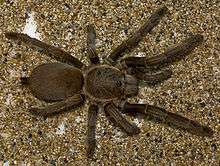Eastern tarantula
| Eastern tarantula | |
|---|---|
 | |
| Scientific classification | |
| Kingdom: | Animalia |
| Phylum: | Arthropoda |
| Class: | Arachnida |
| Order: | Araneae |
| Suborder: | Mygalomorphae |
| Family: | Theraphosidae |
| Genus: | Phlogius |
| Species: | P. crassipes |
| Binomial name | |
| Phlogius crassipes (L. Koch, 1874) | |
| | |
The Eastern tarantula (Phlogius crassipes),[1] also known as, the Barking spider, Bird-eating spider or Whistling spider, is a species of tarantula native to North Queensland, Australia.
Description
The thick footed tarantula has powerful long venomous fangs and can grow up to 1 centimetre (0.39 in) long with a leg span of 23 centimetres (9.1 in) or larger than the size of man's hand. It is recognized as the largest spider in Australia.[1] Due to the hissing sound the spider makes, it has acquired the nickname "Barking spider".[2] They make a whistling sound if they are approached and feel threatened, hence the name "Whistling spider".[3] This species is quite shy and normally does not wander far from its burrow.[4] Females live up to thirty years, males up to eight years.[5]
Venom
The bite from an Eastern tarantula is not fatal to a human, but can cause up to six hours of vomiting. The venom can cause death to a dog or cat within thirty minutes.[1][6]
In May 2010 a scientist living near Cooktown, Queensland, was bitten on her right index finger and experienced symptoms never reported before in research literature. The finger became swollen and very sensitive to touch within one hour. "The pain was so intense that sleep that night was impossible. Fifteen hours post-bite, the adjoining finger and upper hand were also swollen and painful." The pain and swelling were limited to the hand and lower arm only (and not systemic as previously reported) and she reported that they had both eased after 26 hours. Photos were taken at various stages of the swelling.[7]The venom however does not affect a certain cricket known as the bulldog raspy cricket or Sia Ferox. These are part of a group in which are all spider hunters and can kill even the largest spiders.
Habitat
The Eastern tarantula is found throughout North Queensland and is a burrowing arachnid, living underground in burrows, which can be up to 1 metre (3.3 ft) deep, but might be forced into the open during periods of heavy rain.[1] Normally the Eastern tarantula lives in and around gardens or other plant life.[4]
Food
The Eastern tarantula has been known to eat small birds, hence the nickname "Bird-eating spider"; however, they typically eat large insects, small mammals and amphibians, such as cane toads and frogs.[1]
See also
- General
- Australian tarantula species
- Selenocosmia crassipes, Coastal Whistling spider
- Selenocosmia stirlingi, Australian Common Whistling spider
- Selenotypus plumipes, Australian Featherleg spider
Footnotes
- 1 2 3 4 5 Townsville Bulletin: Spider invasion in Bowen Archived October 6, 2009, at the Wayback Machine.
- ↑ Times Online: Giant spiders invade Australian Outback town
- ↑ Brisbane Times: Web of lies: UK press plays up spider 'invasion'
- 1 2 News.com.au: Giant bird-eating spiders invade town
- ↑ SkyNews: Tarantulas Spin Web Of Terror In Oz Town
- ↑ Queensland Museum (2000), p. 40.
- ↑ Raven and Covacevich (2012), pp. 19-22.
References
- Queensland Museum. Wildlife of Tropical North Queensland: Cooktown to Mackay. (2000). ISBN 0-7242-9349-3.
- "New Information on Envenomation by a Whistling Spider, Phlogius crassipes (Family Theraphosidae)." R. J. Raven and J. A. Covacevich. The Queensland Naturalist, Journal of the Queensland Naturalist's Club Inc. Vol. 5
- http://www.australiangeographic.com.au/topics/wildlife/2012/08/australian-spiders-the-10-most-dangerous/
- http://www.planetdeadly.com/animals/australias-dangerous-spiders
- http://australianmuseum.net.au/australian-tarantulas
External links
| Wikispecies has information related to: Phlogius crassipes |
| Wikimedia Commons has media related to Theraphosidae. |
| Look up eastern tarantula in Wiktionary, the free dictionary. |
- Australian
- Australian Tarantula Association
- Steve Nunn's Australian Tarantulas (including notes on classification)
- International